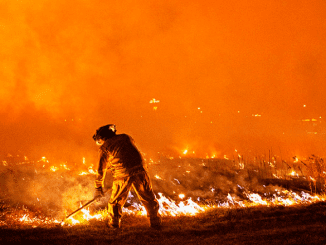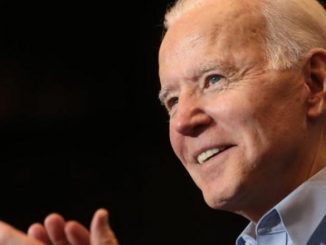
GENEVA, Switzerland, December 30, 2023 (ENS) – The year 2023 shattered climate records, delivered extreme weather, and left death, devastation and despair in its wake laments the World Meteorological Organization, which has pegged 2023 as the hottest year ever recorded.
Since January 1, the global average temperature reached 15.1°Celsius (59.2°Fahrenheit), showing a record 1.46°C (2.63°F) increase from pre-industrial levels. This degree of warming surpassed that for the same period in 2016, the previous warmest year, the WMO says.
Made up of 193 member countries and territories, the WMO facilitates the “free and unrestricted” exchange of data, information, and research among the meteorological and hydrological institutions of its members.
Only 10 United Nations member states are not members of the WMO: Equatorial Guinea, Grenada, Liechtenstein, the Marshall Islands, Palau, Saint Kitts and Nevis, Saint Vincent and the Grenadines and San Marino; but five of them are island states, extremely vulnerable to the effects of climate change.
As the world enters 2024, the WMO reports that:
- – Greenhouse gas levels continue to increase
- – Sea surface temperatures and sea level rise hit record highs
- – Antarctic sea ice hit a record low extent
- – Extreme weather is causing death and devastation
“Greenhouse gas levels are record high. Global temperatures are record high. Sea level rise is record high. Antarctic sea ice is record low. It’s a deafening cacophony of broken records,” said WMO Secretary-General Professor Petteri Taalas of Finland.
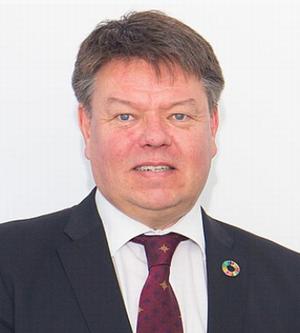
“These are more than just statistics. We risk losing the race to save our glaciers and to rein in sea level rise. We cannot return to the climate of the 20th century, but we must act now to limit the risks of an increasingly inhospitable climate in this and the coming centuries,” Taalas warned.
Extreme weather events are becoming more frequent and severe as a result of the climate crisis, meteorological experts agree. In 2023, a record-breaking cyclone hit southeastern Africa, wildfires devasted vast forests in Chile and Canada, unbearable heatwaves swept across Asia, and powerful ice storms froze the southern United States,
Issued last week, a new analysis from the global nonprofit Save the Children finds that at least 12,000 people – 30 percent more than in 2022 – lost their lives to floods, wildfires, cyclones, storms, and landslides globally in 2023.
For instance, in Pakistan, about 200 people, almost half of them children, were killed in rain-related incidents during the monsoon season which began in late June.
In around 240 such climate-related events this past year, the international disaster database EM-DAT recorded a 60 percent rise in the number of deaths from landslides, a 278 percent increase in deaths from wildfires and a 340 percent increase in deaths from storms between 2022 and 2023. This high number of deaths was driven by the devastating death toll in Libya from the floods after Storm Daniel in September.
Save the Children’s analysis shows how the world’s low income countries have borne the brunt of the climate crisis in 2023, with over half of the people killed in 2023 being from low income or lower-middle income countries. Nearly half, 45 percent, of those killed were from countries responsible for less than 0.1 percent of the world’s greenhouse gas emissions according to the EU’s Emissions Database for Global Atmospheric Research (EDGAR).

Kelley Toole, Global Head of Climate Change at Save the Children said, “The analysis clearly shows how the climate crisis disproportionately affects those who have done least to cause it and are least able to withstand its most damaging effects, further entrenching inequality, poverty, and displacement.
“The thousands of deaths from extreme weather events this year are a particularly stark example of the huge impact that climate change has on children, families, and communities,” Toole said. “Climate disasters leave children homeless, out of school, hungry and fearful that floods, storms, and wildfires will take the lives of their loved ones.”
“We need to significantly scale up climate finance and make it more responsive to children’s needs, including for loss and damage. An agreement to ‘transition away’ from fossil fuels at COP28 is a step in the right direction but falls short of the rapid fossil fuel phase-out desperately needed to secure a just transition for children globally.”
Save the Children works with child climate campaigners who are demanding change. Children across the world are calling for better access to climate education, more funding for climate-resilient infrastructure and a seat at the table with decision makers.
A Life-Saving Essential: Early Warnings for All
“Extreme weather is destroying lives and livelihoods on a daily basis – underlining the imperative need to ensure that everyone is protected by early warning services,” said Taalas. He is urging all WHO members to support the Early Warnings for All initiative, a new program introduced in 2023 to ensure everyone on Earth is protected from hazardous weather, water, or climate events through life-saving early warning systems by the end of 2027.
With human-induced climate change producing more extreme weather conditions, the need for early warning systems is more crucial than ever. But despite the urgent need, only half of the countries worldwide report having adequate multi-hazard early warning systems.
“Early warning systems are not a luxury but a cost-effective tool that saves lives, reduces economic losses, and provides a nearly 10- fold return on investment,” the WMO says.
The Early Warnings for All initiative is co-led by the World Meteorological Organization and the United Nations Office for Disaster Risk Reduction, UNDRR, with support from the International Telecommunication Union, the International Federation of Red Cross and Red Crescent Societies, and other partners.
The initiative was formally launched by UN Secretary-General Antonio Guterres in November 2022 at the COP27 meeting in Sharm El-Sheikh, Egypt.
Issued earlier this month at this year’s UN climate summit, COP28, a new report from the UN Office for Disaster Risk Reduction, UNDRR, and the World Meteorological Organization shows that half of all countries still do not have adequate multihazard early warning systems.
The report, the “2023 Global Status of Multi-Hazard Early Warning Systems,” analyzes the latest data one year into the Early Warnings for All initiative.
Launched earlier this month at the United Nations annual climate summit, COP28, by UN Secretary-General Antonio Guterres, the report finds that 101 countries have an early warning system, an increase of six countries compared to last year, a doubling of coverage since 2015.
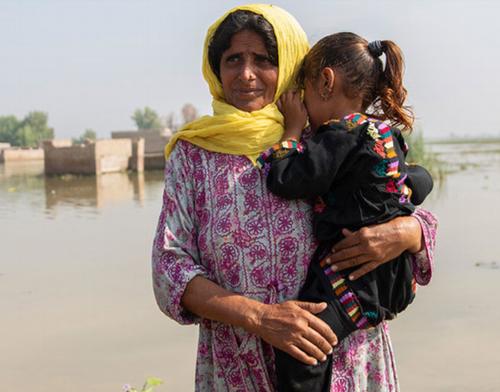
But fewer than half of the world’s least developed countries and only 40 percent of small island developing states have a multihazard early warning system. Risk knowledge to underpin early warning systems was found to be very low in the Arab states.
“What we are delivering under the Early Warnings for All initiative can protect and save vulnerable communities from the worst impacts. This is an ambitious goal, but it is also achievable,” said Guterres. He called for doubling the speed and scale of support in the coming year.
“For us to make it a reality we need all hands on deck rowing in the same direction – collaborating and cooperating in a way that we have not done before,” Guterres urged.
The WMO-UNDRR report found galvanised political commitment and leadership, with 30 countries leading on advancing early warnings and a regional plan in Africa to boost implementation. Africa has doubled the quality of its early warning systems coverage, but still falls below the global average.
“The progress is encouraging but we must not be complacent. With an 80 percent increase in the number of people affected by disasters since 2015 and half the world still lacking access to early warnings, it is imperative to take action now to save lives, livelihoods, and assets,” said Mami Mizutori of Japan, who heads the UNDRR.
“We are making progress but we need to do more. Many countries in Africa, the Pacific and South America still have significant gaps in attaining the minimum number of meteorological observations required to drive forecasting. Early warnings are the low-hanging fruit of climate adaptation. They are not a luxury but a must,” said Prof. Taalas.
New funding will speed more rapid progress and build on the foundations laid since the initiative was launched. The focus now is on scaling up support in more countries and securing the finance to deliver Early Warnings for All in the next four years.
The Early Warnings for All Executive Action Plan calls for investments of US$3.1 billion over five years – 50 cents per person per year – to strengthen disaster risk knowledge and management, observation and forecasting, dissemination and communication of warnings, and preparedness and response capabilities.
It leverages existing pooled funding mechanisms, such as the Climate Risk and Early Warning Systems initiative and the Systematic Observations Financing Facility, as well as global multilateral funds including the Green Climate Fund and the development banks.
Early Warning Systems work through a global reporting of surface and space-based observation data, exchanged among the 193 WMO member countries and fed into advanced supercomputing modeling centers.
The centers run numerical models – mathematical equations that use computers to reproduce the physical interactions of the full Earth System – the planet’s weather, hydrology, ocean, and cryosphere – to create predictions.
The information produced, shared with WMO members from global to regional and national levels, enables national hydrological and meteorological services to offer forecast services to their residents. The WMO says that without this daily, complex, global effort that its work supports, modern weather and hydrology forecasts would not be possible.
World Bank Opens New Climate and Health Program
During COP28 earlier this month, the World Bank announced a new Climate and Health Program to respond to the rising negative health impacts of climate change in low- and middle-income countries.
Through this program, the World Bank will help countries to assess their climate and health vulnerabilities, increase investments in climate-resilient health systems, and work with partners to mobilize additional financing, evidence, and collective action to reduce the impacts of climate change on people’s health and livelihoods.
A warmer climate could lead to at least 21 million additional deaths by 2050 from just five health risks: extreme heat, stunting, diarrhea, malaria, and dengue, new World Bank data shows.
Preventing these deaths requires immediate action to reinforce health systems, particularly in the climate-vulnerable countries of sub-Saharan Africa and South Asia.
The World Bank also estimates that by 2030 the impacts of climate change on health will force 44 million more people into extreme poverty.
“Climate change amplifies health risks, creating a cycle of ill health and poverty with far-reaching consequences for human capital development,” said Mamta Murthi of India, vice president for human development at the World Bank. “Through the Climate and Health Program, the World Bank will use its knowledge and financing to help countries address health risks stemming from climate change, work across related sectors, and bring together partners to maximize financing and harmonize investments and actions.”
The Climate and Health Program will create evidence and knowledge to identify country needs and inform investments. This includes systematically assessing climate-related health vulnerabilities in developing countries, focusing on the impacts on lives, livelihoods, and economies.
Through the program, the World Bank will invest in solutions that are country-tailored and evidence-based and scale-up investments for low-carbon resilient health systems through the bank’s $34 billion health portfolio, which is already active in over 100 countries.
Investments will focus on better surveillance and early warning systems, improving health service delivery in the face of climate-driven disease patterns, climate-proofing health facilities, and strengthening health worker capacity.
Change in Leadership Marks 2024 at WMO
New leaders will direct the WMO next year, headed by the first female secretary-general, Professor Celeste Saulo of Argentina, who takes office on January 1, 2024.
Since July 2014, Dr. Saulo has been director of the Argentinean National Meteorological Service and permanent representative of Argentina at the WMO. She is a PhD graduate from the University of Buenos Aires, specializing in numerical weather prediction, atmosphere dynamics and thermodynamics, mesoscale meteorology, cloud dynamics and cloud microphysics.
Her regional and international activities have been oriented towards capacity building and the inclusion and integration of the younger generations of scientists. At the Argentinean National Meteorological Service she created the WMO Young Earth System Scientists Office.
Her most recent focus has been on climate services for agriculture, early warning systems, and wind energy production.
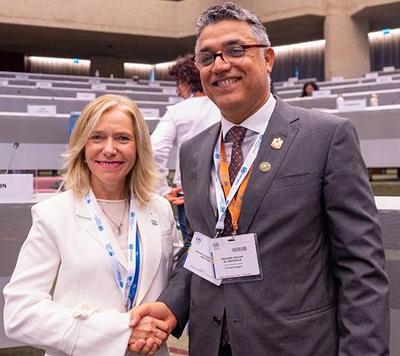
Dr. Saulo will work alongside the new WMO President, Dr. Abdulla Al Mandous, director-general of the National Centre of Meteorology in the United Arab Emirates. It is the first time that a Gulf Cooperation Council meteorologist has been named as the president of the WMO. He succeeds Prof. Gerhard Adrian of Germany who completed his four-year term.
Dr. Al Mandous said that he will focus on, “…on enhancing the resilience of nations to weather and climate-related hazards, strengthening service delivery, promoting knowledge-sharing and capacity building, and increasing the recognition and understanding of WMO’s specialized work, among other priorities,” such as “shaping the global meteorological agenda, promoting sustainable development, and fostering international cooperation in the face of increasing weather-related challenges.”
The WMO President leads sessions of the World Meteorological Congress and Executive Council, which guide WMO weather, water and climate research activities and services.
Professor Taalas, who is completing his eight-year term at the head of the WMO, will return to the Finnish Meteorological Institute and resume his position as the director general at the beginning of 2024.
He commented, “Finland is located in the Arctic region, where the impacts of climate change have been the most severe so far. This process will continue in the future. With the help of high-quality services, functioning of the society can be ensured even in challenging weather conditions.”
“I am happy to be able to return to lead the Finnish Meteorological Institute,” Taalas said, “where I can bring international experience and networks from my position as the secretary general of the WMO.”
Featured image: Heavy smoke and flames rising from the Delabarre Fire burning in Olympic National Park, Washington State, USA, September 16, 2023 (Photo courtesy: InciWeb)

